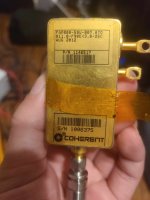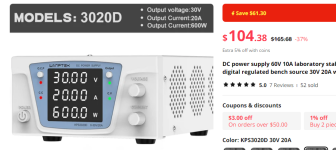
Welcome to Laser Pointer Forums - discuss green laser pointers, blue laser pointers, and all types of lasers
How to Register on LPF | LPF Donations
Navigation
Install the app
How to install the app on iOS
Follow along with the video below to see how to install our site as a web app on your home screen.
Note: This feature may not be available in some browsers.
More options

You are using an out of date browser. It may not display this or other websites correctly.
You should upgrade or use an alternative browser.
You should upgrade or use an alternative browser.
Unable to increase current to laser diode
- Thread starter thompson
- Start date


- Joined
- Sep 20, 2013
- Messages
- 20,284
- Points
- 113
It is likely your diver. As long as you power it with enough voltage that won't sag under the weight of your power supply it should work. Your power supply doesn't seem to be sufficient.
This post was edited because I didn't put the (n't) at the end of doesn't in my last sentence. It was late and I had not looked over it before leaving. I apologize for that.
This post was edited because I didn't put the (n't) at the end of doesn't in my last sentence. It was late and I had not looked over it before leaving. I apologize for that.
Last edited:
I don't use any driver, I connect it directly to the bench powerIt is likely your diver. As long as you power it with enough voltage that won't sag under the weight of your power supply it should work. Your power supply does seem to be sufficient.
Gryphon
0
- Joined
- May 4, 2009
- Messages
- 2,328
- Points
- 113
Power supplies don't push current, you can't push more current than a load will take and you can't receive more current than a supply will generate.
Just because a PSU claims 600W doesn't mean you can always get that 600W out of it. While its true 60V @ 10A is 600W and 30V @ 20A is 600W as well, and logic would dictate that at 2.2V you should be able to get 272A for 600W, the simple fact is very few PSU's are designed to crank out that kind of amperage at that low of a voltage. Most of them aren't made with that consideration in mind.
Think of PSU's are either current limiters or voltage limiters. If you cap the voltage (in CV mode) then hook up the load, the amount of current that flows through the circuit will be capped at either what the supply can generate or what the load can support. It will stop at which ever one it hits first. If you have a 12V supply and add a 1ohm load to it, the most current that you can see through it is 12A assuming the supply is good for that voltage and current combination. Cranking up the "current" knob on the PSU won't make it push more current through that load without something else changing. If you want to increase it to 15A through that 1ohm load then the voltage across it will need to be increased to 15V.
When we set up laser diode drivers we set the current we would like to see, it sets a limit or a cap on the maximum amount of current that can flow. Because voltage and current are tied together, the driver (behind the scenes and without any intervention from the user) adjusts the voltage output accordingly to be appropriate for the load. Laser diodes differ from traditional resistors in that their resistance change across a given range but the same laws still apply.
Just because a PSU claims 600W doesn't mean you can always get that 600W out of it. While its true 60V @ 10A is 600W and 30V @ 20A is 600W as well, and logic would dictate that at 2.2V you should be able to get 272A for 600W, the simple fact is very few PSU's are designed to crank out that kind of amperage at that low of a voltage. Most of them aren't made with that consideration in mind.
Think of PSU's are either current limiters or voltage limiters. If you cap the voltage (in CV mode) then hook up the load, the amount of current that flows through the circuit will be capped at either what the supply can generate or what the load can support. It will stop at which ever one it hits first. If you have a 12V supply and add a 1ohm load to it, the most current that you can see through it is 12A assuming the supply is good for that voltage and current combination. Cranking up the "current" knob on the PSU won't make it push more current through that load without something else changing. If you want to increase it to 15A through that 1ohm load then the voltage across it will need to be increased to 15V.
When we set up laser diode drivers we set the current we would like to see, it sets a limit or a cap on the maximum amount of current that can flow. Because voltage and current are tied together, the driver (behind the scenes and without any intervention from the user) adjusts the voltage output accordingly to be appropriate for the load. Laser diodes differ from traditional resistors in that their resistance change across a given range but the same laws still apply.
- Joined
- Aug 31, 2016
- Messages
- 949
- Points
- 93
As the current increases so will the voltage requirements. If you have it locked at 2.2V then you won't be able to go any higher with the current. Try setting the voltage to 2.5V and slowly increasing the current from 0V. You may need to go even higher than 2.5V to get the full output but that's a good place to start.
Will the diode be burned if I go higher than 2.2V?


As the current increases so will the voltage requirements. If you have it locked at 2.2V then you won't be able to go any higher with the current. Try setting the voltage to 2.5V and slowly increasing the current from 0V. You may need to go even higher than 2.5V to get the full output but that's a good place to start.
- Joined
- Sep 20, 2013
- Messages
- 20,284
- Points
- 113
Will the diode be burned if I go higher than 2.2V?
View attachment 77911
The point is that in order to get a higher current you MUST increase the voltage. You can do this in stages if you prefer. Just increase the voltage by 0.1 volts at a time.
- Joined
- Aug 31, 2016
- Messages
- 949
- Points
- 93
You could probably just set the voltage to 5+ volts and as long as you don't increase the current past it's max input then it will only use the voltage it requires at the given current. I'm not saying to do that but I do it all the time and it's fine. Laser diodes need current regulation more than voltage regulation. I've found that the voltage on datasheets rarely matches up with reality.
By saying stage, do you mean slowly increase the voltage instead of maximum output at one time?The point is that in order to get a higher current you MUST increase the voltage. You can do this in stages if you prefer. Just increase the voltage by 0.1 volts at a time.
- Joined
- Sep 20, 2013
- Messages
- 20,284
- Points
- 113
By saying stage, do you mean slowly increase the voltage instead of maximum output at one time?
Getting rid of waste heat is your main problem. So, I wouldn't allow a lot of time between increases in voltage.



